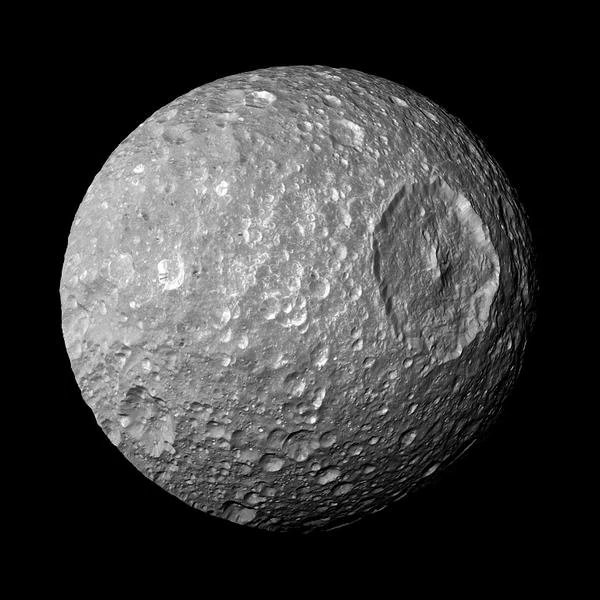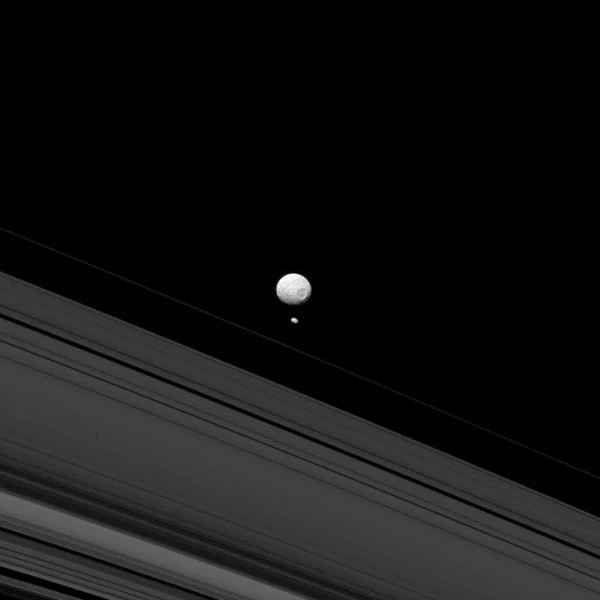
Mimas, one of Saturn's inner moons (diameter: 396 km), is famous for its Herschel crater, which gives it a striking resemblance to the Death Star from Star Wars. Discovered in 1789 by William Herschel (1738-1822), it exhibits unique geological features:
Mimas is in synchronous rotation with Saturn, always showing the same face to the planet. Its nearly circular orbit makes it a key object for studying orbital resonances with other moons like Tethys and Enceladus.
N.B.:
Mimas: Name derived from Greek mythology (son of Gaia, killed by Ares during the Gigantomachy).
The most striking feature of Mimas is its Herschel crater, named after its discoverer:
| Property | Value | Comparison |
|---|---|---|
| Diameter | 130 km | 1/3 of Mimas' diameter (near the destruction limit) |
| Depth | 10 km | Almost as deep as the Grand Canyon |
| Central peak | 6 km high | Almost as high as Everest |
| Estimated age | ~4.1 billion years | Late Heavy Bombardment period |
| Estimated impactor | 5-10 km in diameter | Could have shattered Mimas into pieces |
Three major consequences of this impact:
Data from the Cassini mission suggest a relatively simple internal structure:
Unlike Enceladus, Mimas shows no evidence of a subsurface ocean, likely due to its small size (rapid cooling), lack of tidal heating (low orbital eccentricity), and advanced age (surface dated to ~4 billion years).
| Type | Description | Examples |
|---|---|---|
| Impact craters |
|
|
| Pits and grooves |
|
|
| Smooth terrains |
|
|
Mimas formed ~4.5 billion years ago in the circum-Saturnian disk. Its history can be summarized in 3 phases:
The Cassini probe performed several flybys of Mimas between 2005 and 2017:
| Observation | Implications |
|---|---|
| Thermal asymmetry between hemispheres | Possible difference in texture or composition |
| Absence of geysers or activity | Unlike Enceladus, Mimas is geologically dead |
| Measured librations (oscillations) | Indicate a rigid internal structure or an elongated core |
| Characteristic | Mimas | Enceladus | Tethys | Dione |
|---|---|---|---|---|
| Diameter (km) | 396 | 504 | 1,062 | 1,123 |
| Density (g/cm³) | 1.15 | 1.61 | 0.984 | 1.48 |
| Geological activity | None | Active cryovolcanism | Ancient (craters) | Tectonic faults |
| Particularity | Giant Herschel crater | Vapor plumes | Grand canyon (Ithaca Chasma) | "Wispy terrain" fractures |

Although Mimas (396 km in diameter) and Pandora (81 km) differ radically in size and position, they maintain a subtle gravitational relationship that illustrates the complexity of the Saturnian system. Pandora, a "shepherd moon" of the F Ring, and Mimas, guardian of the Cassini Division, are connected by two key phenomena:
1. Indirect Orbital Resonance
Mimas and Pandora are not in direct resonance (as Mimas is with Tethys), but their interaction occurs through:
2. Complementary Role in Ring Stabilization
The two moons play opposite but complementary roles:
| Characteristic | Mimas | Pandora |
|---|---|---|
| Position | Orbits 185,539 km from Saturn | Orbits 141,700 km (just outside the F Ring) |
| Effect on the Rings | "Cleans" the Cassini Division via 2:1 resonance with particles | "Confines" the F Ring with Prometheus (co-shepherd moon) |
| Mechanism | Gravitational resonance destructive (ejects particles) | Tidal effects constructive (maintains ring edges) |
| Consequence | Creates "empty lakes" in the rings | Prevents the dispersion of the F Ring |
3. An Asymmetric but Vital Relationship
Although Pandora is 5 times smaller than Mimas, their interaction reveals how:
This complementarity explains why Saturn's rings are both stable over millions of years and dynamic on a small scale.
Observational Evidence (Cassini mission):
Note:
Although Mimas and Pandora are not in direct resonance, their interaction is a perfect example of a chain of gravitational perturbations in planetary systems. This relationship illustrates how celestial bodies of very different sizes can coexist in dynamic equilibrium, a key principle for understanding the stability of ring systems.